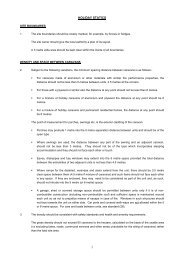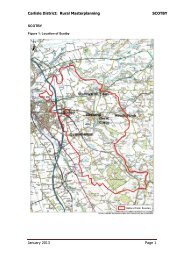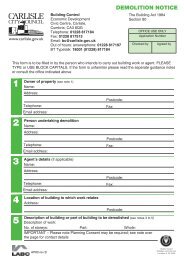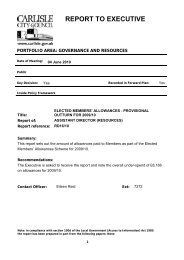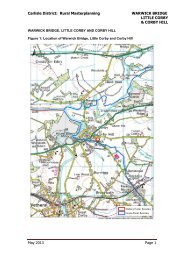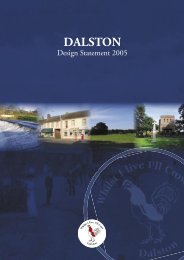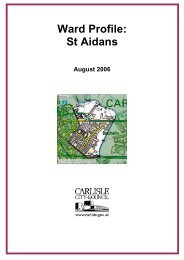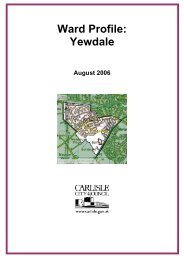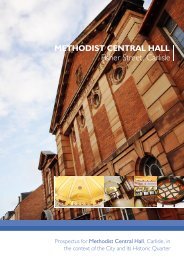Carlisle District Local Plan.indd - Carlisle City Council
Carlisle District Local Plan.indd - Carlisle City Council
Carlisle District Local Plan.indd - Carlisle City Council
Create successful ePaper yourself
Turn your PDF publications into a flip-book with our unique Google optimized e-Paper software.
<strong>Carlisle</strong> <strong>District</strong> <strong>Local</strong> <strong>Plan</strong> 2001 - 2016 Revised Redeposit draft6.44 Wherever possible, in situ preservation is the preferred option. It may be possible, forexample, to adjust the siting of the proposed development so that the foundations donot damage the archaeological remains. There will be occasions where the quality ofthe remains and the need for the development do not justify the in situ preservation ofthe remains. In these circumstances and where the applicant is able to demonstrate thatsatisfactory arrangements have been made to excavate and record, permission will begiven.6.45 <strong>Plan</strong>ning permission will be refused where proposals for development fail to take account ofboth the archaeological importance of the site and the resources required to undertake theinvestigation of the remains.6.46 Investigation of archaeological remains will be undertaken by excavation, post excavationanalysis and publication. On sites where damage to the archaeological remains is minimal,or on those sites which can be regarded as expendable, investigations may be confined to awatching brief.POLICY LE10 Archaeological Field EvaluationOn all scheduled and other nationally important monuments, sites of archaeologicalsignificance and other sites of high archaeological potential, the <strong>City</strong> <strong>Council</strong> willensure that the archaeological aspects of development proposals are examinedand evaluated either before planning applications are determined or in exceptionalcircumstances by the use of condition. <strong>Plan</strong>ning permission will not be granted withoutadequate assessment of the archaeological implications.6.47 The <strong>City</strong> <strong>Council</strong> considers that early discussions with developers can help to reconcile theneeds of archaeology and development and reduce potential conflict. These discussionswill highlight any potentially sensitive sites and in these circumstances the <strong>City</strong> <strong>Council</strong> willrecommend that developers commission their own archaeological assessment by a qualifiedarchaeologist.6.48 A field evaluation is normally a rapid and inexpensive operation which may involve smallscale trial trenching and ground survey. Evaluations of this kind serve two purposes.Firstly, they help to define the character and extent of the archaeological deposits inthe development area and thus indicate the weight which ought to be attached to theirpreservation. On this basis, an informed decision on the planning application can bemade. Secondly, information from the field evaluation can be used to identify ways in whicharchaeological deposits can be physically preserved and/or recorded, which is possible inthe majority of cases.POLICY LE11 Enhancement of Major Archaeological SitesThe <strong>City</strong> <strong>Council</strong> will encourage proposals which enhance major archaeological sites.6.49 The <strong>Plan</strong> area includes a number of archaeological sites of major significance. Themost important of these is Hadrian’s Wall and its associated features, such as forts andmilecastles. Hadrian’s Wall is possibly the best known archaeological feature in the countyand a significant proportion of it is located in the <strong>Plan</strong> area, including some well preservedsections of the Wall itself and the fort at Birdoswald.106 September 2006



